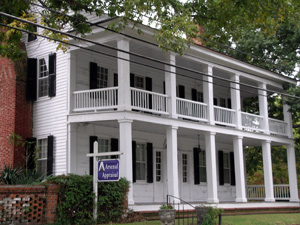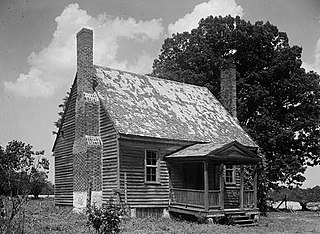
Lincoln County is a county located in the U.S. state of North Carolina. As of the 2020 census, the population was 86,810. Its county seat is Lincolnton.

The camp meeting is a form of Protestant Christian religious service originating in England and Scotland as an evangelical event in association with the communion season. It was held for worship, preaching and communion on the American frontier during the Second Great Awakening of the early 19th century. Revivals and camp meetings continued to be held by various denominations, and in some areas of the mid-Atlantic, led to the development of seasonal cottages for meetings.
Denver, formerly known as Dry Pond, is a census-designated place and unincorporated community in Lincoln County, North Carolina, United States. As of the 2010 census it had a population of 2,309.
Iron Station is an unincorporated community and census-designated place (CDP) in Lincoln County, North Carolina, United States. A primarily industrial town, Iron Station's population was 755 as of the 2010 census. It also serves as a bedroom community for the larger cities of Charlotte, Hickory, and Lincolnton.

The Market House is a Market house and town hall in the center of Fayetteville, Cumberland County, North Carolina. It was built in 1838 on the site of the old state house and Town Hall which burned down in 1831. Fayetteville was the capital of North Carolina from 1789 to 1794.

Indian Field Methodist Campground is a camp meeting site for the Methodist Church in Dorchester County, South Carolina. It is on SC Route S-18-73, off US Route 15, about 5 mi (8 km) north of Saint George. Indian Field was built in 1848 and has been a site for religious gatherings for over 160 years. It is associated with the Indian Field United Methodist Church located on U.S. Highway 15 about 2 miles (3 km) north of the campground and just south of U.S. Highway 178. It was named a historic district of the National Register of Historic Places on March 30, 1973.

Anderson Camp Ground is a historic camp ground in Brushy Creek, in Anderson County, Texas, United States.

Cypress Methodist Camp Ground is a historic Methodist camp meeting in Ridgeville, Dorchester County, South Carolina. Cypress Camp Ground was functional as early as 1794, and an adjacent cemetery contains graves from the early 1800s. The campground is in the general shape of a rectangle of 34 tents, or cabins, made of rough-hewn lumber. These cabins, rectangular shaped, are generally 1 1/2-stories and contain earthen floors.

Mount Carmel A.M.E. Zion Church & Campground is a historic African Methodist Episcopal Zion camp meeting grounds in Heath Springs, South Carolina, Lancaster County, South Carolina. It was established in 1866 and consists of a complex of approximately 55 small "cabins" or "tents" and the brick church of Mt. Carmel A.M.E. Zion Church is located in the general form of a rectangle. Mount Carmel A.M.E Zion Church Campmeeting starts every year on the first Wednesday in September, and last for 4–5 days. An "arbor," or open-air structure, is located in the center of the complex, where music, gospel singing, praise and worship, preaching and teachings are held. People come to worship, fellowship, network, and eat food from as far as New York City, NY to Orlando, FL. There is also a section on the grounds for vendors. The majority of the cabins are small frame, some are two story cabins for larger families made from concrete block and wooden structures. Also on the property is the church cemetery.

Charles C. Hartmann (1889–1977) was an American architect.

St. Paul Camp Ground, also known as St. Paul A.M.E. Camp Ground, is a historic African Methodist Episcopal camp meeting and national historic district located near Harleyville, Dorchester County, South Carolina. The district encompasses 43 contributing buildings. It was established about 1880, and the buildings and grounds are used for one week each year. The tabernacle is a one-story building clad in rough-sawn weatherboard. Also on the property are 54 tents, two stores, and a storage house.

Camp Welfare is a historic African-American religious campground located near Monticello, Fairfield County, South Carolina. It was founded after the American Civil War by the African Methodist Episcopal Zion Church. It is a collection of approximately 100 one-story, frame, weatherboarded cabins called tents arranged in a double "U"-shape. The focal point of the camp is the arbor; a rough, gable roofed wooden shelter with wooden benches. Also located at the camp is Zion Church; a frame building with a gable roof surmounted by a belfry built about 1930.
Cattle Creek Campground, also known as Cattle Creek United Methodist Church and Campground, is a historic camp meeting ground that is now a national historic district located near Rowesville, Orangeburg County, South Carolina. The district encompasses 37 contributing buildings and 1 contributing site. It was founded in 1786, although this date has been challenged. The campground burned in 1898 and was rebuilt. Another fire in 2017 destroyed 15 "tents," which were again rebuilt. It includes 36 cabins, called “tents,” arranged in a wide semi-circle. They are located around an open, 56 feet by 81 feet, pavilion structure known as the “stand” or “tabernacle.” Also located on the property is a cemetery. It is one of three remaining Methodist campgrounds in South Carolina.

Balls Creek Campground is a historic Methodist camp meeting and national historic district located near Bandy's Crossroads, Catawba County, North Carolina.

Cool Spring Place, also known as Cool Spring Tavern, is a historic home located at Fayetteville, Cumberland County, North Carolina. It was built in 1788, and is a two-story, five bay by four bay, rectangular Federal style frame dwelling. It low hipped roof and features a double porch on the front facade. It operated as a tavern until 1795, and is believed to be the oldest existing structure in the city of Fayetteville, having survived the disastrous fire of 1831.
Chapel Hill Church Tabernacle is a historic Methodist church tabernacle located near Denton, Davidson County, North Carolina. It was built in 1870 and enlarged in the 1920s. It is a one-story, heavy-timber, open-framework building, open on three sides. It has a concrete floor and a gable-on-hip roof. The tabernacle was originally used for the religious services at the annual camp meetings. The tabernacle is located on the grounds of Chapel Hill United Methodist Church, whose congregation dates from 1854.

Cascine is a historic plantation complex and national historic district located near Louisburg, Franklin County, North Carolina. The district encompasses 12 contributing buildings, 4 contributing sites, and 3 contributing structures. The main house was built about 1850, and is a large two-story, Greek Revival style frame dwelling, in the manner of Jacob W. Holt, with Gothic Revival style influences. Also on the property is a small, one-story frame dwelling dated to about 1752. It was repaired and refurbished in the mid-20th century. Also on the property are the contributing brick kitchen, frame stable, granary, carriage house, family cemetery, slave cemetery, remains of slave quarters, tenant house, six log and frame tobacco barns, grist mill complex, and archaeological sites.

Ingleside is a historic house located near Iron Station, Lincoln County, North Carolina. It was built about 1817, and is a two-story, five bay by three bay, Federal style brick mansion. The front facade features a pedimented portico supported by four Ionic order stuccoed brick columns. It was built by Congressman Daniel Munroe Forney, son of Congressman Peter Forney.
Tucker's Grove Camp Meeting Ground is a historic African Methodist Episcopal Church camp meeting ground located near Iron Station, Lincoln County, North Carolina. Tucker's Grove Camp Meeting begins the 3rd Saturday of August, and continues until the 4th Sunday, also called 'Big Sunday'. Throughout the week of Camp Meeting, hundreds of camp participants move to the grounds to attend worship services and fellowship with family and friends.

The Pleasant Grove Camp Meeting Ground is a historic Methodist camp meeting national historic district located near Waxhaw, Union County, North Carolina. The district encompasses four contributing buildings and one contributing site. The main building is the arbor that dates to 1830. It is an 80 feet long by 60 feet wide open sided frame structure with a gable roof surround on all four sides by pent roof extensions. Located nearby are the church and former schoolhouse, now used as the preacher's dwelling, and the old cemetery.



















